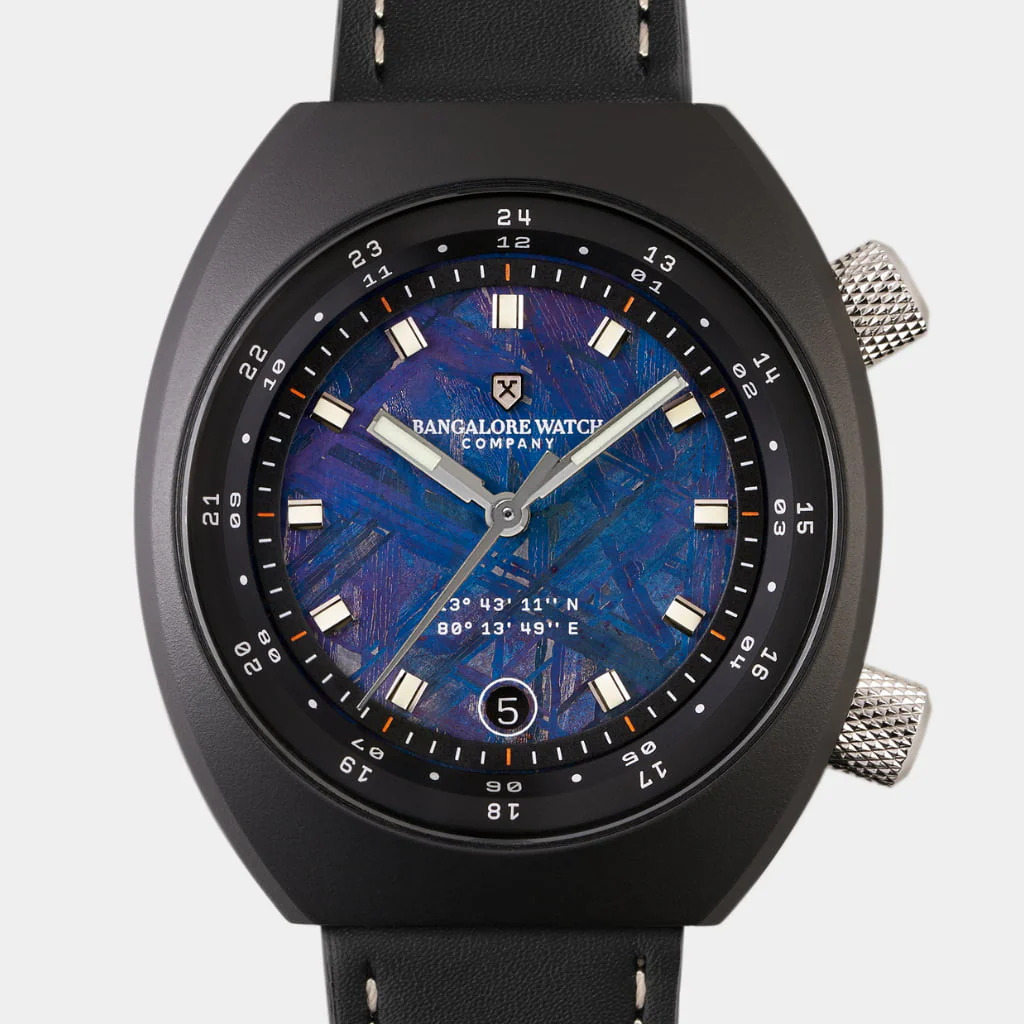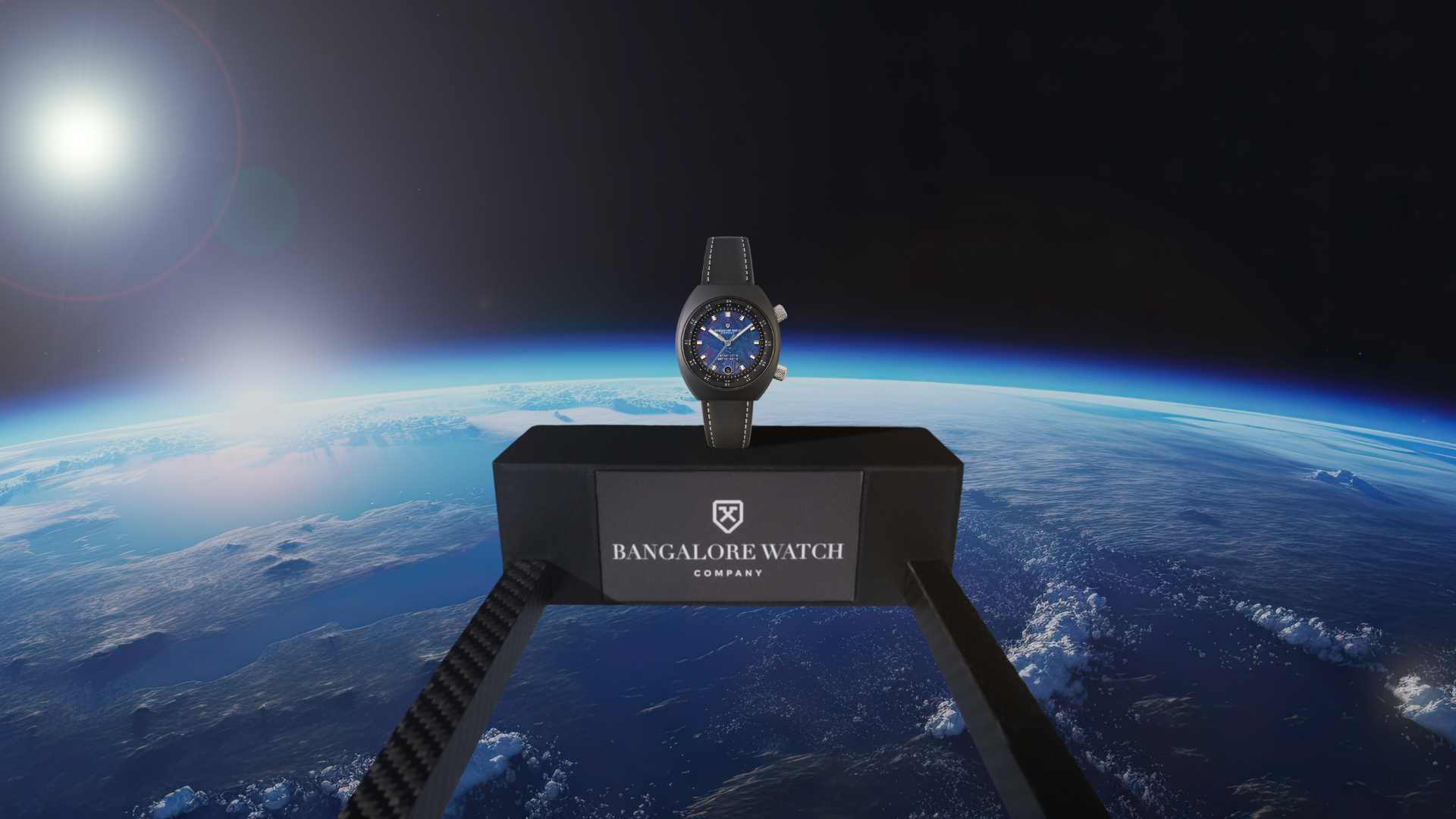Earlier this year, an Indian watch was taken into space and dropped back to Earth. The watch, Apogee Karman Line by Bangalore Watch Company, survived extreme pressure and temperature changes, and came back in perfect running condition. The brand’s co-founder Niurpesh Joshi says it is the first step to eventually putting the timepiece on an astronaut’s wrist, much like a Sturmanski, worn by Soviet pilot Yuri Gagarin aboard his Vostok 1 in 1961, or a Strela strapped to Russian Cosmonaut Alexi Leonov in open space, or even an Omega Moonwatch that Edwin ‘Buzz’ Aldrin wore when he stepped out of Apollo 11 onto the lunar surface in 1969.

Joshi and co-founder Mercy Amalraj founded Bangalore Watch Company with the vision of representing modern India in its timepieces. Its collection Cover Drive is inspired by cricket, and MACH1 is an homage to Indian aviation; the Apogee line takes inspiration from India’s space missions. Now, an Apogee watch has literally made it to the final frontier. “We took two Apogee watches built in the exact same workshop and put them through additional testing to make sure that they would withstand the extremities of space, and sent one to space,” says Joshi. “We never used different materials to build this watch. It’s the same Apogee series watch in just a different-coloured case that we took, tested, and sent up. This milestone gives us the opportunity to call the whole Apogee series space-qualified.” The watch is named after the boundary, marked 100 kms above the Earth, believed to be the starting point of outer space.
The Karman Line
The design of Karman Line is largely the same as the other Apogee timepieces. Crafted in 40mm black CerasteelTM and topped with domed sapphire crystal with two layers of anti-reflective coating, where it stands out from other Apogee watches is with its blue Muonionalusta meteorite dial. This ferrous-based meteorite was found along the borders of Sweden and Finland and is commonly used by watchmakers; Bangalore Watch Company’s manufacturing partners in Switzerland cut and processed the rock to make it a dial to be fitted inside this watch. The blue colour of the meteorite is reminiscent of blue skies in space.

The indexes and hands are diamond cut, rhodium coated, and layered with C3 Grade-A Super-LumiNova® for nighttime visibility. The date window lies at 6 o’clock. The crown at 4 is for timesetting, and the one at 2 can be used to set the second timezone using the internal bezel. The caseback is closed and screwed down, and features an engraving of the Aryabhatta, India's first satellite, like all other Apogee watches.
The other significant difference in this watch is its movement. While other Apogee watches house Sellita movements, the Karman Line is powered by La-Joux Perret G100 manufacture movement, which offers the watch 68 hours of power reserve and drives the time and date functions. The watch is flanked with a genuine leather strap closed with a 316L steel tang buckle featuring BWC logo.
The flight
The watch went up to an altitude of 114,000 feet (35 kms) in the Earth’s atmosphere, four times higher than the height of Mount Everest, where it was still within the gravitational pull of the Earth. To make this flight happen, Bangalore Watch Company joined hands with a UK-based space-engineering company, who created a carbon-fibre spacecraft and a hydrogen-filled high-altitude balloon to carry the Apogee watch to outer space. The watch was mounted over a special-created spacecraft and left completely exposed to the extreme environment of about -60 degree celsius.
Any watch that goes into outer space has to be tested for extreme conditions, including abrupt temperature and pressure changes. Joshi says that on ground, the watch was put through a battery of tests for the same, though these were far less punishing than the final conditions it was exposed to. “We didn’t know how high the watch would go, we tested it to the maximum extent we could on the ground [-30 degree Celsius], and it went till 35 kms at -60 degree Celsius and the watch still worked flawlessly. And that’s something we’re really proud of,” said Joshi. It was only after the watch passed all the tests that it was handed over to partners in the UK for the space flight.
The launch
As per Joshi, the three main aspects of this project were the location, mode of launch, and testing the watch. “First, we zeroed in on the company who would carry our watch into space. Second, we had to decide how we were going to send it - either in a rocket or a high-altitude balloon. We couldn't spend hundreds of dollars sending it in a rocket, so the best way was to send it in a high-altitude balloon. The third decision was to build a spacecraft where it was exposed to the elements of space. It was a challenge for us to build a spacecraft that was only 2 kgs and could support a watch over it, and had multiple 4K cameras focusing on the watch,” says Joshi. The company was secretly working on the project for the past 18 months before it reached the milestone.
The descent
After reaching the maximum extent in space, the watch stayed there for a brief period and then the balloon was deflated through a remote mechanism. The spacecraft then free-fell back to Earth at a speed of about 350 kmph, and as it approached the ground, a drogue parachute was deployed to slow it down to almost 8 kms/hr. Through this controlled descent, the watch touched down on Earth and was found in a perfect running condition. It was traced to have landed at about 20 kms from where it took off because of the winds.

After successfully testing the Apogee for space, Joshi aims to put this watch on the wrists of astronauts. “It was just a space-inspired watch with some pretty-looking fume dials three years ago, and now we have meteorite dials and have even pushed ourselves to make it space-qualified. We are now looking forward to the future where we can put these watches on the wrists of not just Indian astronauts, but the astronauts of other countries as well. The next milestone will be to put the Apogee to human-rating, which will involve fire-retardant, shock-absorbent testing and more.”
Also expected are more updates in design and materials. “When we launched Apogee, we made a titanium watch. We wanted to make it even better so last year we introduced a proprietary material called Cerasteel, a combination of stainless steel and ceramic. It’s harder, you can play around with colours, and is more robust than stainless steel. Now we continue to make improvements to and investments in this series, and hopefully tell the world that we are a very serious watch company trying to do very serious stuff.”
Images: Courtesy Brand














